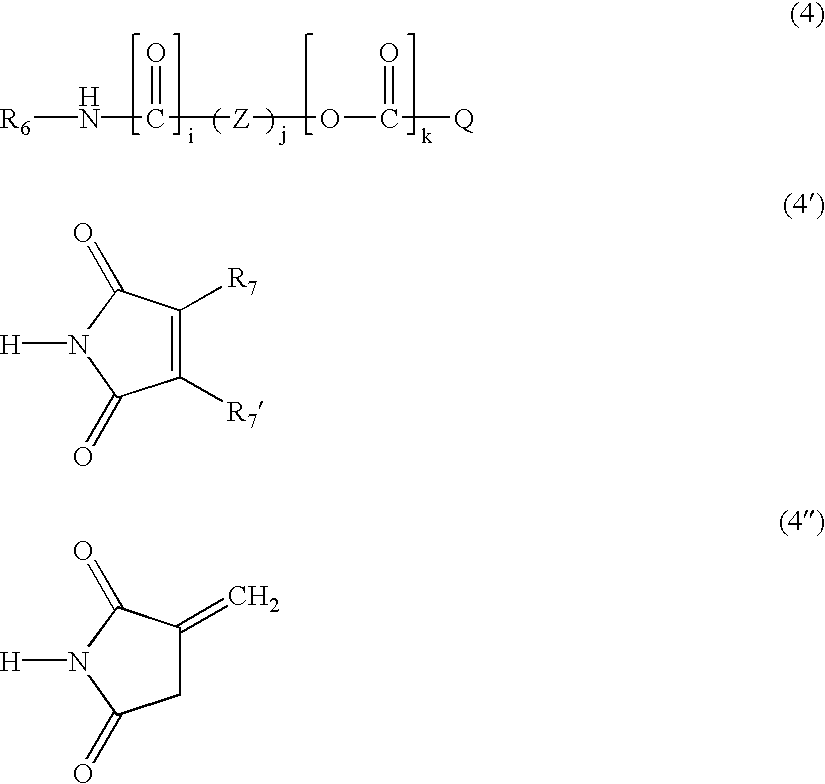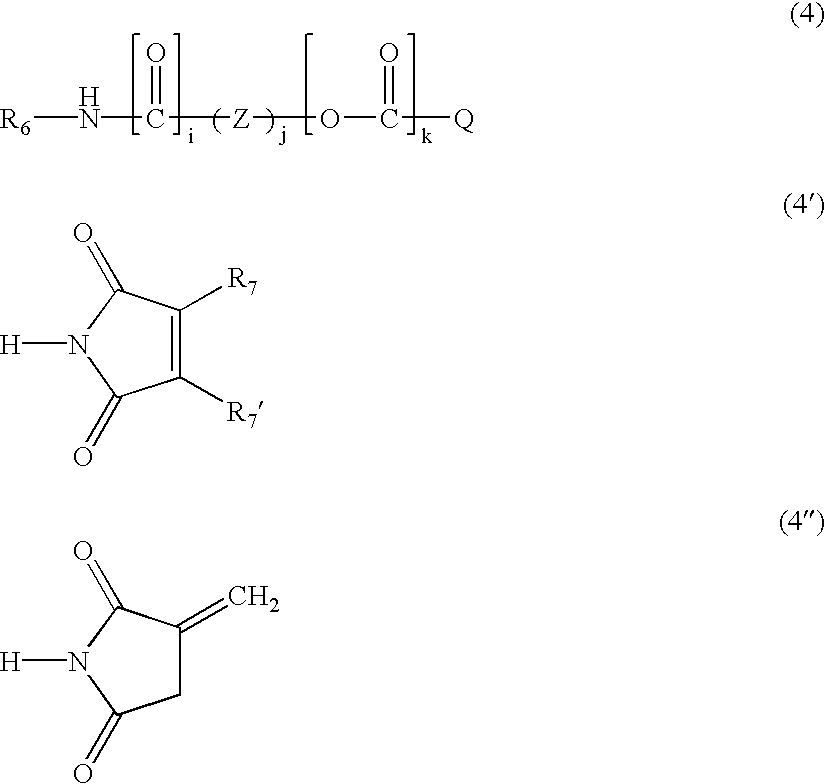Radiation-curable prepolymers
a technology of prepolymer and radioactive material, applied in the field of radioactive material preparation, can solve the problems of contact lens even breaking, cracking, flaws or tears, etc., and lowering the overall production yield
- Summary
- Abstract
- Description
- Claims
- Application Information
AI Technical Summary
Benefits of technology
Problems solved by technology
Method used
Image
Examples
example 1
General Procedures
[0159]PEG, Poly(THF)-650, IPDI, and TMP are purchased from Aldrich Chemical. Pluronic and reverse Pluronic products are obtained from BASF. Irgacure 2959 is obtained from CIBA specialty corporation.
[0160]FT-IR spectra are recorded on a BioRad FTS-175 spectrometer. Samples for IR analysis are prepared be smearing neat poly(urethane) samples between NaCl disks.
[0161]Molecular sieves are activated by heating them at about 400° C. for several hours and then stored in a desiccator.
[0162]Unless otherwise stated, viscosity is measured at 30 RPM, #16 spindle, at 25° C. using a Brookfield viscometer. The sample is centrifuged for 15 minutes at 4000 RPM prior to viscosity measurement.
[0163]The percentage of NCO in samples is determined by titration Using Mettler Toledo Autotitrator.
[0164]Pin Hole Test are carried out as follows: Lenses are punctured with a 22 gauge needle, folded in half and then rolled 2–3 times between fingers. If a lenses does not fracture, it is given a ...
example 2
Preparation of Isocyanate-Capped Polyurethane Polymer
[0167]To a 60° C. melt consisting of PEG-1000 (84.53 g), Pluronic 17R2 (9.480 g), TMP (2.983 g) and IPDI (34.690 g) is added dibutyltindilaurate (DBTDL) (0.65 g). The temperature of the reaction mixture increased to about 90° C. due to the exothermicity of the isocyante polyol reactions. About 30 minutes after the addition of the DBTDL titration of NCO revealed that conversion of isocyanate is close to the theoretically predicted value. FT-IR analysis of the sample showed an NCO peak near 2267 cm−1 and a urethane peak near 1720 cm−1.
Preparation of Radiation-Curable Prepolymer
[0168]Approximately 14.47 grams of poly(urethane) 1525-68 is mixed with 1.30 grams of TBAM at room temperature. The sample is checked by FT-IR and additional TBAM is added until the isocyante peak is no longer visible. A 30% solids water solution of photocurable poly(urethane) is prepared by adding 37.40 grams of an aqueous solution containing 0.043% Irgacure ...
example 3
Preparation of Isocyanate-Capped Poly(urethane)
[0170]PEG-900 (75.03 g), Pluronic 17R2 (9.355 g), TMP (2.216 g) are combined and allowed to melt at 60° C. The melt is dried over 3A activated molecular seives for about 20 hours. To the melt is added IPDI (32.40 g) and 0.63 g of dibutlytindilaurate (DBTDL). The temperature of the reaction mixture increased to about 90° C. soon after the addition of DBTDL. The reaction mixture is allowed to continue heating in a 60° C. oven for about 2 hours. The percent NCO in the sample is determined by titration to be close to the theoretically predicted value.
Preparation of Radiation-Curable Prepolymer
[0171]About 14.95 grams of Poly(urethane) 1525-66 is mixed at room temperature with 1.95 grams of TBAM. The sample is analyzed by FT-IR and additional TBAM is added dropwise until NCO is no longer present in FT-IR spectra. A 30% solids water solution of photocurable poly(urethane) is prepared by adding 39.41 grams of an aqueous solution containing 0.04...
PUM
| Property | Measurement | Unit |
|---|---|---|
| temperature | aaaaa | aaaaa |
| time | aaaaa | aaaaa |
| time | aaaaa | aaaaa |
Abstract
Description
Claims
Application Information
 Login to View More
Login to View More - R&D
- Intellectual Property
- Life Sciences
- Materials
- Tech Scout
- Unparalleled Data Quality
- Higher Quality Content
- 60% Fewer Hallucinations
Browse by: Latest US Patents, China's latest patents, Technical Efficacy Thesaurus, Application Domain, Technology Topic, Popular Technical Reports.
© 2025 PatSnap. All rights reserved.Legal|Privacy policy|Modern Slavery Act Transparency Statement|Sitemap|About US| Contact US: help@patsnap.com



